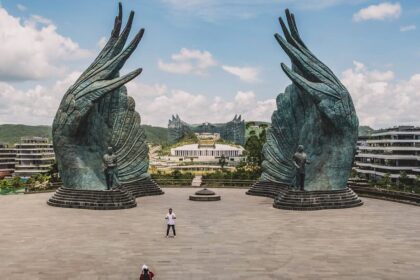China’s Historic Chang’e-6 Mission: A New Era in Lunar Exploration
In June 2024, China’s Chang’e-6 mission made history by returning the first-ever samples from the far side of the Moon, specifically from the enigmatic South Pole–Aitken (SPA) basin. This achievement not only marks a major milestone for China’s rapidly advancing space program but also opens a new chapter in international lunar science, offering unprecedented insights into the Moon’s formation, evolution, and the broader history of the solar system.
- China’s Historic Chang’e-6 Mission: A New Era in Lunar Exploration
- Why the Far Side and South Pole–Aitken Basin Matter
- Mission Overview: How Chang’e-6 Brought Back the Moon’s Hidden Secrets
- Scientific Breakthroughs: What the Chang’e-6 Samples Reveal
- Solving the Lunar Dichotomy: Why Are the Moon’s Two Sides So Different?
- International Collaboration and Scientific Access
- The Next Steps: China’s Ambitious Lunar Roadmap
- Global Competition and Cooperation: The New Space Race
- Broader Implications: What Chang’e-6 Means for Science and Humanity
- In Summary
The Chang’e-6 mission is part of China’s ambitious Chang’e lunar exploration program, which has evolved from a newcomer to a pioneering force in just two decades. The mission’s success is a testament to China’s growing technological prowess and its commitment to contributing to global scientific knowledge.
Why the Far Side and South Pole–Aitken Basin Matter
The Moon’s far side, perpetually hidden from Earth’s view, has long been a source of scientific intrigue. Unlike the near side, which is dominated by vast, dark plains of solidified lava known as lunar maria, the far side is characterized by rugged highlands and a scarcity of volcanic features. This stark contrast, known as the lunar dichotomy, has puzzled scientists for decades.
The SPA basin, where Chang’e-6 landed, is the largest and oldest known impact crater on the Moon, stretching 2,500 kilometers across and plunging up to 10 kilometers deep. Formed by a colossal asteroid impact about 4.25 billion years ago, the SPA basin is a geological treasure trove. Its ancient rocks and soils hold clues to the Moon’s earliest history and the violent processes that shaped the inner solar system.
Until Chang’e-6, all lunar samples returned to Earth came from the near side, leaving a significant gap in our understanding of the Moon’s global evolution. The new samples from the SPA basin are expected to revolutionize lunar science by providing direct evidence from this unexplored region.
Mission Overview: How Chang’e-6 Brought Back the Moon’s Hidden Secrets
Launched in May 2024, Chang’e-6 was designed as a technically complex mission, building on the successes of its predecessors. The spacecraft included a lander, an ascender, an orbiter, and a reentry capsule. After a precision landing in the southern Apollo basin—a sub-basin within the SPA region—the lander used a drill and robotic arm to collect nearly two kilograms of lunar soil and rock.
The samples were then transferred to the ascender, which launched from the lunar surface and rendezvoused with the orbiter in lunar orbit. The precious cargo was finally delivered to Earth, parachuting down to the grasslands of Inner Mongolia, where it was quickly retrieved by recovery teams.
This intricate choreography demonstrated not only China’s engineering capabilities but also the command and control techniques essential for future human and robotic exploration of the Moon and beyond.
Scientific Breakthroughs: What the Chang’e-6 Samples Reveal
Early analyses of the Chang’e-6 samples have already yielded groundbreaking discoveries:
- Dating the SPA Basin: By examining impact melt rocks and norite clasts within the samples, Chinese scientists have precisely dated the formation of the SPA basin to 4.25 billion years ago. This provides a crucial anchor point for reconstructing the Moon’s early history and refining the timeline of solar system impacts.
- Volcanic Mysteries: The samples contain basalt fragments that formed from cooling magma about 2.8 billion years ago—much more recently than previously thought for the lunar far side. This suggests that volcanic activity persisted longer on the far side than expected, despite the absence of heat-producing elements found on the near side.
- Water Content and the Moon’s Origin: Analysis shows that the mantle beneath the far side contains significantly less water than the near side, supporting the giant impact hypothesis for the Moon’s formation. This theory posits that the Moon formed from debris after a Mars-sized body collided with the early Earth.
- Geochemical Diversity: The samples reveal a complex mixture of local basaltic material and foreign non-mare (non-volcanic) fragments, offering insights into the Moon’s crust, mantle, and the processes that have shaped its surface over billions of years.
These findings are already reshaping theories about the Moon’s evolution and the broader history of planetary bodies in the solar system.
Solving the Lunar Dichotomy: Why Are the Moon’s Two Sides So Different?
One of the most enduring mysteries in lunar science is the pronounced difference between the Moon’s near and far sides. The near side is covered by extensive lava plains, while the far side is dominated by highlands and has far fewer volcanic features. The Chang’e-6 samples are helping scientists address this puzzle.
Research indicates that the crust on the far side is much thicker than on the near side, which may have prevented magma from reaching the surface and forming large maria. The samples from the Apollo basin, with their varied titanium content and evidence of multiple volcanic eruptions, provide a unique window into the Moon’s internal processes and the factors that drove its asymmetric evolution.
As Dr. Yuqi Qian of the University of Hong Kong explains, “This fundamental finding indicates that the crustal thickness discrepancy between near side and far side may be the primary cause of lunar asymmetrical volcanism. This can be tested by the returned Chang’e-6 samples.”
International Collaboration and Scientific Access
China has emphasized that its lunar exploration program is open to international cooperation. The Chang’e-6 mission carried scientific payloads from France, Italy, Pakistan, and the European Space Agency, reflecting a spirit of global partnership. Chinese officials have announced plans to share the returned samples with researchers worldwide, fostering collaborative studies that transcend national boundaries.
Shan Zhongde, head of the Chinese Space Agency, stated, “We look forward to scientists worldwide making more scientific discoveries, jointly expanding human knowledge and benefiting all of humanity.”
Despite political tensions and legal restrictions—such as the U.S. Wolf Amendment, which limits direct NASA-China collaboration—scientists from multiple countries are eager to study the Chang’e-6 samples. Multilateral arrangements and international partnerships are enabling broader access to these invaluable materials.
The Next Steps: China’s Ambitious Lunar Roadmap
The Chang’e-6 mission is just one part of a broader, multi-phase Chinese lunar exploration strategy:
- Chang’e-7 (2026): This mission will target the lunar south pole, deploying an orbiter, lander, rover, and a mini-hopping probe to search for water ice and study the region’s environment and resources. The mission will carry 21 scientific payloads, including international instruments, and aims to land near the illuminated rim of Shackleton crater.
- Chang’e-8 (2028): Focused on technology demonstrations, this mission will test in-situ resource utilization—such as extracting oxygen and hydrogen from lunar soil—and lay the groundwork for a future lunar research station.
- International Lunar Research Station (ILRS): China, in partnership with Russia and other countries, plans to establish a permanent research base at the lunar south pole by 2035. The ILRS will be open to global participation, with a vision of involving 50 countries, 500 institutions, and 5,000 scientists.
- Crewed Lunar Landing: China aims to land astronauts on the Moon by 2030, rivaling NASA’s Artemis program, which targets a crewed landing as early as 2026.
These missions are not only advancing science but also demonstrating the technologies and operational expertise needed for sustained human presence on the Moon and, eventually, Mars.
Global Competition and Cooperation: The New Space Race
The success of Chang’e-6 has intensified the global race to explore and utilize the Moon, particularly its south pole, which is believed to harbor water ice—a critical resource for future lunar bases and deep space missions. Both China and the United States are vying to establish a foothold in this strategically valuable region.
NASA Administrator Bill Nelson has expressed concerns about the competitive nature of lunar exploration, stating, “My concern is that they [China] get to the south pole first and then say, ‘this is our area, you stay out,’ because the south pole of the moon is an important part… We think that there is water there and if there’s water, then there’s rocket fuel.”
However, China has reiterated its commitment to peaceful exploration and international cooperation, emphasizing that the Moon “belongs to all of humanity.” The United Nations Outer Space Treaty, ratified by both the U.S. and China, prohibits national appropriation of lunar territory but leaves room for “first mover” advantages in establishing infrastructure and operations.
Broader Implications: What Chang’e-6 Means for Science and Humanity
The Chang’e-6 mission’s scientific and diplomatic achievements have far-reaching implications:
- Advancing Planetary Science: The new samples provide critical data for understanding the Moon’s origin, the timeline of solar system impacts, and the processes that shaped terrestrial planets.
- Resource Utilization: Insights into the composition of lunar soils and the presence of water ice are essential for developing technologies to support human exploration and potential lunar industry.
- International Collaboration: By sharing samples and inviting global participation, China is fostering a more inclusive approach to space exploration, setting a precedent for future missions to the Moon, Mars, and beyond.
- Strategic Competition: The race to the lunar south pole is not just about science—it is also about national prestige, technological leadership, and securing access to resources that could shape the future of space exploration.
In Summary
- China’s Chang’e-6 mission returned the first-ever samples from the Moon’s far side, specifically the South Pole–Aitken basin.
- The mission has provided direct evidence dating the SPA basin’s formation to 4.25 billion years ago, anchoring the timeline of lunar and solar system history.
- Analysis of the samples reveals unexpected volcanic activity, differences in water content, and new clues about the Moon’s origin and evolution.
- China is sharing the samples with international researchers, promoting global scientific collaboration despite geopolitical tensions.
- Future Chinese missions, including Chang’e-7 and Chang’e-8, aim to explore the lunar south pole, search for water ice, and test technologies for a permanent research station.
- The Chang’e-6 mission marks a new era in lunar exploration, with profound implications for science, international cooperation, and the future of humanity in space.












